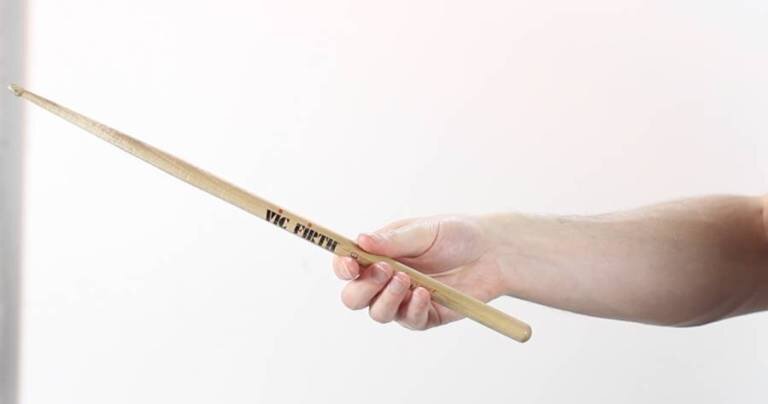Here’s a set of exercises for those of us who want to develop faster bass drum technique but don't use a double pedal. I find this type of graduated arrangement yields greater freedom when applying it to music.
Read moreDon't-cha-wanna-dance?
No, actually, I don't. This came into focus for me some years ago. It was one of those wonderful, serendipitous, off-the-cuff remarks that ended up being a defining moment. I was at the wedding of a close relative and one of the bridesmaids came over to me and tried to get me to dance. I politely declined (I’m even less into dancing than I am into singing). Her comeback was rather convincing: “When you hear the music, don’t you just want to get up and dance?” My response was even better: “No, I want to sit down and hit things!”
Read moreis this even a rudiment?
It occurred to me recently that I’d never seen anything on Double Paradiddle-diddles. Don’t even know if they’re a thing, but interesting nonetheless. I started by doing them hand-to-hand.
Read morePutting Your Finger On It - Part 2: The Thumb
My teacher used the expression "Feel the money." It was a reference to using the thumb the way you would to count out paper money. In effect, you use the thumb to help push the stick forward, causing it to arc around the first finger. If you're looking for pinpoint control and articulation on the cymbal, this is the way to do it.
Read morePutting Your Finger On It, Part I - "Regular Grip"
A lot of drum instruction focuses on hand and wrist movement. While it's important to understand these broad strokes, it's also important to look inside hand technique to see what's really going on. Each digit has a role to play in the grip and the stroke, and understanding what each finger is capable of can make a big difference in your playing.
Read moreThe Collector
Strolling Through History - I like to do research, and I can tell you a little bit about each of the drums in my “collection”. Aside from the details of the drums, I've learned a lot about history, culture, tradition ... even economics and interpersonal relationships. It's also broadened my understanding and appreciation of the history and culture behind drums.
More Fun with Stick Control
I like to mix things up with Stick Control. Here I’ve moved the figures to the snare and bass and laid a ‘funk’ ride pattern over top. These can all be played at the same tempo but the feel changes depending on where you put the hi-hat.
The Latin Clave* Demystified
It's difficult these days (maybe even impossible) to turn on a music station and not hear a Latin clave pattern. Dig deeper and you'll find clave rhythms or some derivative just about everywhere: the clave 'clap' of hip-hop, the bossa bass drum in Rosanna, the venerable Bo Diddly beat … it's all clave.
Read moreBeware The Thick Black Line
Consider for a moment the following bits of wisdom:
• At a wine tasting: “We only drink merlot”
• From an online ad for a 16-inch cymbal: “I won't play it 'cuz I only play 18 inch crashes”
• And how about this morsel from years ago: “There’s no place for the saxophone in jazz”
It crops up all the time: the invisible, immovable line that divides the acceptable from the unacceptable.
Read moreWhat Weaker Side?
Hmmm ... there seems to be some sort of problem with this thing called the weaker side. While I agree with the general concept that our non-dominant side is often less adept than our natural side, there are other factors to consider in this issue outside of equality.
Read moreI'm of two minds on this...
Or maybe three. But definitely not one. It's an exercise I find myself doing a lot as I work on things that challenge me: trying to get my mind -- not just my limbs -- to focus on two things at once.
Read moreCure For Idle Hands - Stick Control Unleashed Part I
The exercises in Stick Control are great for getting your hands moving, so why not use them to get the other limbs involved as well? The following interpretations move the stickings around the entire drum set. While the idea is to get all four limbs working, it’s best to go easy at first, i.e. start with two limbs, then add the third (and then the fourth) when ready.
Read moreRelease Your Inner __________ (insert drummer of choice)
Tribute band Mini Kiss
What Daniel suggests, and I fully endorse, is that you step inside the other artist's skin for a few minutes. He even goes as far as to suggest you imagine yourself as that drummer to help you emulate their style and energy.
Read moreNo Bad Drum Heads
There are today a lot of companies making drum heads, ranging from the global standards -- Remo, Evans, etc. -- to boutique makers such as Earthtone and Kentville. And of course, every maker offers a variety of styles, sometimes to the point of our total bewilderment.
Read moreJust Shuffling Around
There are many different types of shuffle rhythms available, and each one was 'purpose built' for a particular style of music. Note that your basic shuffle is often written as dotted 8th & 16th notes, but it's rarely played that way. Strict adherence to 1(e&)a 2(e&)a 3(e&)a 4(e&)a tends to sound mechanical or choppy, and just not swinging. Counting 1~uh 2~uh 3~uh 4~uh leaves you free to interpret and fine tune the feel of a shuffle. i
Read moreReview - Essential Snare Drum Exercises and Mastering The Snare Drum by Mat Marrucci
The first thing that struck me about Mastering the Snare Drum was the
sheer weight of the thing. In a little over 100 pages, the book covers
just about everything a snare drummer would need.
All Diets Work! (Slightly related to Thanksgiving and Drums!)
The same might can be said of drum exercises. They all work because they all get your hands (and feet) moving. But, like diets, not all exercises are equal. Some will transport your playing to the next level, while others won’t have much impact on your actual playing, and some may send you off in the wrong direction.
Read moreInspiration From The Stars
I picked up a copy of the Sabian publication “Create: 2017 Cymbals & Sounds”. It’s a 40-page full color magazine provided free by Sabian and distributed through music equipment outlets. It’s really just a catalog of their various products, but it delivers quite a bit more. The book is filled with information about cymbals: how they’re made, how they’re used, how designs came about, what different features mean. There’s lots of cymbal lore and history too. If someone wanted to quickly learn about cymbals, this edition would be a great place to start.
Read moreA Bright Idea
When we speak of tone, we often use terms like warm, round, dark, and the like. Each tone quality has its place, but the one that many drummers seem to forget about is bright. It's one thing for our drums to sound great when we're seated behind them, but what does it sound like out front?
Read moreLet's Get Married
Perhaps you're teamed with a bass player who doesn't lay down a solid line. Or maybe someone in the band just doesn't connect. In either case my recommendation is to work with the strongest or the weakest player.
Read more









